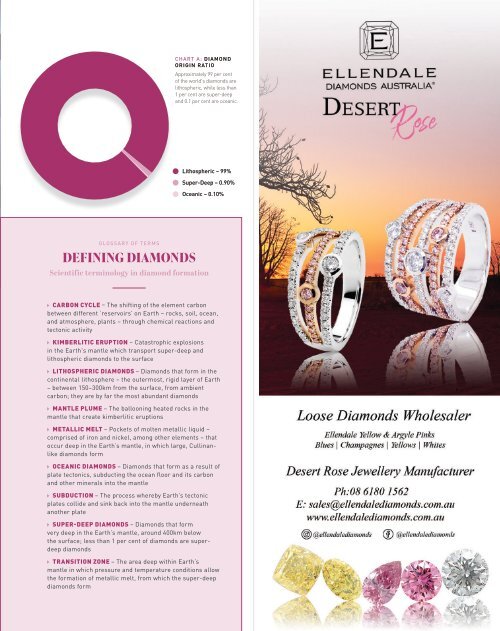You also want an ePaper? Increase the reach of your titles
YUMPU automatically turns print PDFs into web optimized ePapers that Google loves.
S<br />
CHART A: DIAMOND<br />
ORIGIN RATIO<br />
Approximately 99 per cent<br />
of the world's diamonds are<br />
lithospheric, while less than<br />
1 per cent are super-deep<br />
and 0.1 per cent are oceanic.<br />
Lithospheric – 99%<br />
Super-Deep – 0.90%<br />
Su<br />
Oceanic – 0.10%<br />
Oceanic – 0.10%<br />
Super-Deep – 0.90%<br />
Lithospheric – 99%<br />
GLOSSARY OF TERMS<br />
DEFINING DIAMONDS<br />
SCIENTIFIC REPORT<br />
Super-Deep Diamonds<br />
Scientific terminology in diamond formation<br />
CARBON CYCLE – The shifting of the element carbon<br />
between different ‘reservoirs’ on Earth – rocks, soil, ocean,<br />
and atmosphere, plants – through chemical reactions and<br />
tectonic activity<br />
KIMBERLITIC ERUPTION – Catastrophic explosions<br />
in the Earth's mantle which transport super-deep and<br />
lithospheric diamonds to the surface<br />
LITHOSPHERIC DIAMONDS – Diamonds that form in the<br />
continental lithosphere – the outermost, rigid layer of Earth<br />
– between 150–300km from the surface, from ambient<br />
carbon; they are by far the most abundant diamonds<br />
MANTLE PLUME – The ballooning heated rocks in the<br />
mantle that create kimberlitic eruptions<br />
METALLIC MELT – Pockets of molten metallic liquid –<br />
comprised of iron and nickel, among other elements – that<br />
occur deep in the Earth’s mantle, in which large, Cullinanlike<br />
diamonds form<br />
OCEANIC DIAMONDS – Diamonds that form as a result of<br />
plate tectonics, subducting the ocean floor and its carbon<br />
and other minerals into the mantle<br />
SUBDUCTION – The process whereby Earth’s tectonic<br />
plates collide and sink back into the mantle underneath<br />
another plate<br />
SUPER-DEEP DIAMONDS – Diamonds that form<br />
very deep in the Earth’s mantle, around 400km below<br />
the surface; less than 1 per cent of diamonds are superdeep<br />
diamonds<br />
TRANSITION ZONE – The area deep within Earth’s<br />
mantle in which pressure and temperature conditions allow<br />
the formation of metallic melt, from which the super-deep<br />
diamonds form


















